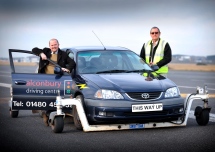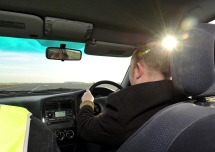Alconbury Driving Centre Article By John Baker
Reproduced by kind permission of The Peterborough Evening Telegraph - article by John Baker – Peterborough Evening Telegraph Published on Thursday 19 January 2012 10:40
According to the website www.uk-roadsafety.co.uk there have already been 89 deaths on UK roads this year, and almost 10,000 casualties. Driver error may have been a factor, but adverse weather and road conditions will also have played their part.
Alconbury Driving Centre can provide drivers with skills which may prevent accidents – and save lives. Deputy features editor John Baker took to the road:
In February 2005, I had just acquired a new 1.8 litre Peugeot 306, and I felt great. With a striking dashboard of red and white, the nippy little monster really looked the part as it zoomed me towards work in the fens one morning, and although there was a light covering of snow, the back roads seemed fine.
Then I drove between two hedgerows which prevented the morning sunbeams from hitting the road surface, and the little car lost its grip in the ice. It happened so quickly I had no time to react and smashed sideways into a tree in a ditch, stunned and upset by the abrupt action. I wasn’t injured. The little car was a write-off.
I don’t know whether advanced skills would have aided me – I don’t think Sebastian Vettel would have rescued himself on that thin road with ditches either side – but every time I go past that giant tree I think back to that bleak morning, and count myself lucky it wasn’t worse.
Driving in ice, or on water, or braking at high speed, are three components of the advanced skills courses taught at Alconbury Driving Centre, based at Alconbury Airfield and boasting what was once Europe’s largest runway.
 I was given a flavour of the skid training the school provides in a morning of control, concentration and the occasional calamity alongside ET photographer Ben Davis, who also took to the wheel.
I was given a flavour of the skid training the school provides in a morning of control, concentration and the occasional calamity alongside ET photographer Ben Davis, who also took to the wheel.
Firstly, driving centre manager Paul Staple told us about the various courses on offer, and tested us on what we knew about driving.
A 20-question quiz asked posers including whether a worn tyre had been ground down by understeering or oversteering, and what were the effects of ABS anti-lock braking.
Students are then taught what causes a lack of control and skidding.
Paul said of the programmes: “Some people take to them naturally, but you do see experienced drivers who probably aren’t as aware as they should be.
“A lot of people have the training in their head, but when it comes to doing it practically it goes out of the window.
“We teach defensive driving, which is the skill of looking ahead. For example, this morning you will get people driving in bright sunlight, who will then move into shadow, without thinking about the different conditions on the road – and if they are not careful they will be off it.
“We have had at least one gentleman who came to us for training, and we took him through braking and avoidance, and braking at 40mph with ABS. I said that the chances of him having to do it were small if he was a good driver, but maybe once every 10 years he might have to.
“The very next day he had to hit his brakes; if he hadn’t had the training he would have ploughed into the vehicle in front.”
Once the theoretical work is over we head to the mile-long strip of road.
 We would be taking an abridged version of one of the centre’s courses in skid training, a quick demonstration of each skill in a standard Toyota Avensis with ABS.
We would be taking an abridged version of one of the centre’s courses in skid training, a quick demonstration of each skill in a standard Toyota Avensis with ABS.
While I operate it using the gears, pedals and steering wheel, instructor John Smith can alter the degree of friction between the wheels and road surface through a simple keypad. An hydraulic lifting system regulates the four pivot wheels which are mounted on the skid car frame, which means that rear and front wheel skidding can be simulated.
Once the seat is adjusted for my short frame I take to the runway, and the car and I are friends. I steer and he follows, slaloming through the marked areas with aplomb.
Little gremlins then crawl into the works – John starts to simulate an incremental lack of responsiveness in the rear wheels, unnoticed at first, until one movement is too severe and I shoot sideways, pirouetting like a drunken ballerina.
Once I become attuned to the lack of integrity I manage a few successful attempts, although there are still a few quivers and jerks.
When my swearing has finished echoing around the car we try advanced braking, an emergency stop on the motorway combined with a swift lane change, as if a large vehicle has stopped ahead which must be avoided. With ABS you can just slam your foot down as hard as you want and adroitly turn into the next lane, the pedal juddering beneath you as it pumps the brakes and the ‘gaps’ in the braking allow you to turn. Slam on the brakes without ABS and the wheels will lock. Steering will be severely compromised, meaning you will lose control and smash into the articulated lorry in front.
The correct technique is cadence braking, a pumping action of the foot which mimics ABS, allowing more freedom of turning.
It’s tricky to pump a pedal and turn a steering wheel at the same time.
One attempt spins me 45 degrees and sees me clip the rear of the vehicle in front. One is far too slow and results in annihilation.
Only when the pumping action becomes more natural does the turning action become flowing.
Combating aquaplaning is a case of resisting the urge to steer excessively. Once the wheels are drifting it only needs an inch or two of correction to straighten the steering.
Finally I try some figure-of-eight drives around a set of cones, under various conditions of understeer and oversteer caused by ice – in the snowy climes of Scandinavia these skills are part of a standard driving test. The former is relatively straightforward, the latter anything but.
The same error of accelerating too early and therefore exacerbating the curve, coupled with not steering early enough, threw me into a circle of oblivion on several occasions.
It was an abridged session and therefore I was on my way to taming the actions, without quite mastering them. But I finished better than I started, and had some great fun along the way.
Ben then took to the wheel, and if someone had been watching from the sidelines they would probably believe he was playing the fool.
As a rear seat passenger in the Avensis-turned-carousel I can assure them that was not the case. If nothing else his brief dodgem-car drive showed the difficulty of the techniques.
The price for the three hour skid car experience is £110, while the “serious side” skid car course, spread over three one-hour sessions, costs £155.
Paul added: “Drivers who take the courses can enhance their existing skills and develop further ones. Driving a vehicle is the most dangerous thing we do on a day-to-day basis. For many people the car is an extension of their work, and the best insurance they can have is their own skills and knowledge.”
OTHER COURSES AT ALCONBURY:
Schools Driving Programme: Once a week for an academic year, students can learn driving skills. The course for Year 11 students has seen more than 80 young people attending each week for a two-hour session of practical and classroom study. They learn about motor vehicle history, motoring maths, first aid, car safety checks and the Highway Code, and spend an hour per week in a dual-control car picking up skills.
Individuals can take the Programme 16 young drivers course, a three hour programme for youngsters who are too young to hold a driving licence. It gives them the chance to learn skills which will eventually make them a better driver when they get behind the wheel.
The private driving circuit features traffic lights, roundabouts, pedestrian crossings, and parking manoeuvres.
Both courses for young people are run in conjunction with the Cambridgeshire Police Shrievalty Trust.
Corporate events: These can be team building/entertainment events, and a source of information.
Paul said: “Some companies don’t realise they have a duty of care for their business, if their employees drive during work. If anything happened they could be charged with corporate manslaughter. We ask employers if things are in place to lower the risk of accident, such as vehicle checks and eyesight tests and we can offer driver assessments.”
Clients who have used the centre’s services include Cambridgeshire police, the NHS, BP, Cambridgeshire Fire and Rescue Service, ROSPA, and the Luminus Group.
